
All categories
Featured selections
Trade Assurance
Buyer Central
Help Center
Get the app
Become a supplier

(2718 products available)





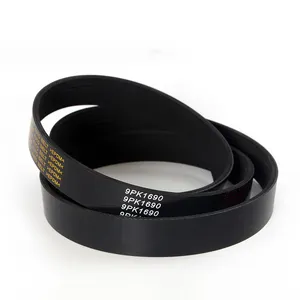

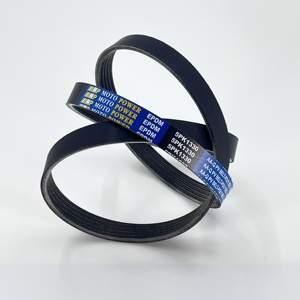
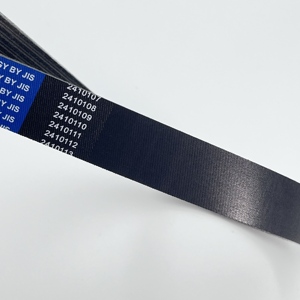





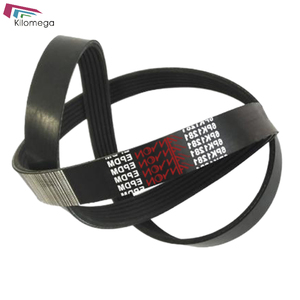
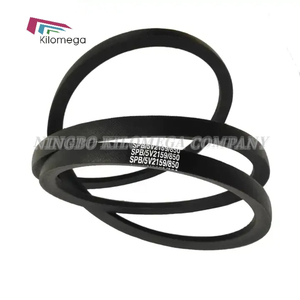







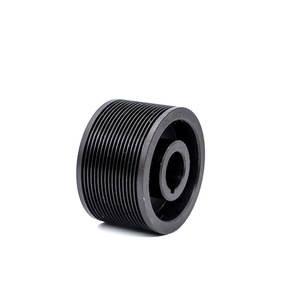


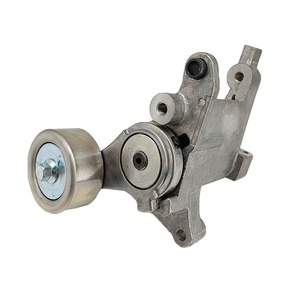





Ribbed belt pulleys have types differentiated by materials, number of grooves, and applications. People in various industries must choose the right pulley for efficiency to reduce wear and tear on belts.
Common variations include:
Spurious
Ribbed belt drive pulleys are intelligent and have no grooves so they can efficiently transmit power through a belt. They are typically used in applications where belt slip is often experienced. However, since they do not add friction, these pulleys are used with other pulley types in multi-stage belt systems.
Multiplicity of ribs
The number of ribs on a ribbed belt pulley can vary depending on the task. Large pulleys with more grooves are used in high-torque engineering tasks, while smaller pulleys are used in low-power household machinery. The pulley system's design engineers determine the required groove number.
Rounding and flat pulleys
Round ribbed belt pulleys are used in vertical applications for belts with misalignment tolerance. Flat ribbed belt pulleys are used where precision in alignment is required because pressed belts offer deformation resistance. Flat pulleys are more common in simple and low-speed machines, while round pulley domes are high-speed concentrators.
Conical pulleys
Ribbed pulleys can adjust the tension and speed by changing the position of the belt on the grooved surface inclined cone shape pulleys. A typical belt drive system comprising ribbed belt pulleys also uses conical pulleys to enhance speed ratio control, which is especially important in variable-speed applications like lathes and drill presses.
Metallurgy
Pulleys are made from metals such as steel and aluminium alloys, which provide strength and corrosion resistance. Steel pulleys are more wear-resistant hence used in heavy-duty industrial tasks. Aluminum pulleys have comparable durability but are relatively lightweight and do not generate as much heat; thus, they are among the preferred choices in the automotive industry. These pulleys are fabricated using CNC machining to achieve superior accuracy and precision.
Engineered plastics
For applications with lower loads, ribbed pulleys are often made from sturdy plastic polymers such as polyamide, acetal, or polycarbonate. These materials are lighter and may be more resistant to chemical solvents. Plastics allow easier belt slip, especially in slower mechanic assemblies. Plastic pulleys are fabricated through injection moulding, which is effective for mass production.
Rubber coating
A rubber coating is applied to metal pulleys to reduce wear during contact, enhance shock absorption, and augument resistance to slip. Rubber covers also increase the friction necessary for efficient power transmission. The durability of the coated material depends on the grade of rubber and the frequency the assembly is used. Common applications requiring a longer belt and life between replacements have rubber-coated ribbed pulley systems.
Resistance to abrasive wear
The design of ribbed belt pulleys incorporates materials that resist abrasion, such as metals with hardness levels above steel or polymers filled with aramid or glass fibres for increased wear resistance. Some have ceramic coatings on the grooves for added hardness. Grooves are also designed to have a narrow profile and be wedge-like, which concentrates stress in a small contact zone and increases wear resistance of the belt and pulley system.
Industry that deals with automotive
In automobiles, ribbed belt pulleys are critical in serpentine belts to drive multiple accessories like alternators, power steering, water pumps, and air conditioning units from the engine crankshaft. Pulleys ensure these devices operate smoothly and efficiently as they transmit power over long distances. Auto design focuses on reducing parasitic resistance and optimizing power transmission, enhancing accessory performance, fuel economy, and engine load reduction.
Advanced technology
In information technology and computing, machine pulleys are vital for disk drives, fans, and other drive systems that power internal components. Pulley design precision and low friction are crucial for maintaining data integrity and ensuring that computer fans operate at the required cooling capacity with minimal energy expenditure. IT relies on lightweight plastic or metal pulleys to keep machines quiet, cool, and efficient.
Manufacturing and beyond
Ribbed pulleys transmit power between shafts and various rotating machinery; hence, they are a fundamental component in the industrial production line. They drive motors, conveyors, pumps, mixing, heating, and stirring machines. Since pulleys link multiple machines, they must be durable, standardized, and easily maintained. Industrial designs focus on strengthening materials and reducing wear so pulleys can handle more loads.
Home appliances
Ribbed belt pulleys are integral to household washing machines and refrigerators. They drive the drum in washing machines, enabling washing cycles, and drive cooling fan and compressor systems in refrigerators. These pulleys balance power transmission and space constraints to ensure home appliances operate reliably. Enhanced designs also focus on reducing noise and vibration.
Textiles and fibers
The ribbed belt pulley system is key to efficiently operating spinning, weaving, knitting, and garment finishing machines in textiles and apparel manufacturing. They drive multiple shafts to run crucial components, ensuring these tasks are performed at the correct speeds. Pulley durability and correct design maintain the desired torque in textile machines that undergo constant load changes to produce quality fabrics and garments.
Characteristics and quality control standards
Ribbed belt pulleys have a corrugated surface that increases friction, enhancing the belt's grip and reducing slippage. They are lightweight yet durable, made of metals like aluminum or steel for industrial applications, or plastics for lighter machinery. Key features include conical or flat designs for variable or fixed motion transfer and CNC or injection moulding for high precision. In quality assurance, standards guide testing for material strength, alignment precision, and wear-resistance coating.
Sustainability considerations
For ribbed belt pulleys, sustainability considers using eco-friendly materials like recycled metals, reducing energy during manufacture, and designing for a longer life to decrease waste. Responsible sourcing of raw materials, especially metals, and plastic alternatives reduces environmental impact. Additionally, systems can be designed to allow easy repair or replacement of parts like bearings, further minimizing resource use and pulleys' overall carbon footprint.
Compatibility with the pulley system
The ribbed belt pulley system used in a machine determines the efficiency of the chosen pulley. The machine's motor power, shaft diameter, and speed characteristics help select the cord belt pulleys for the job. The groove profile and spacing on the pulley must match the belt width and design to promote optimal contact to minimize wear and slippage. Consult the manufacturer's specifications for information on pulley and ribbed belt compatibility.
Material and longevity
Metal pulleys made from aluminum or steel stand up to the loads and are resistant to deformation in tough environments. Plastic pulleys are lightweight but have lower strength and are best for applications with lesser force. Consider environmental elements like moisture, heat, or chemicals: corrosion-resistant coatings such as zinc on metal or rubber on plastic to enhance pulley life in harsh operating conditions.
Torque handling and size
The pulley diameter affects the speed and torque transferred. Larger pulleys distribute torque more evenly and reduce belt wear. Smaller pulleys are more compact and increase system speed with greater torque concentration. Choose a size that balances installation limit and torque requirement for the intended task. Consult a mechanical engineer for guidance on pulley dimensions concerning torque and other machine speeds.
Sustainability considerations
Sustainability drives some of the choices available for pulleys. More recycled materials like metals and plastics are used to mould engineering plastics for pulleys. Longer-lasting pulleys reduce the frequency of replacements and, hence, resource consumption. Low-energy manufacture pulleys further decrease environmental impact. Choose the durable and maintenance-free pulley that sustainably fulfills the desired task requirements.
A1: The ribbed belt pulley is made for the ribbed belt to ride on when power is being transmitted through from one component to the other.
A2: Grooves run parallel to the cord and on the ribbed belt pulleys are deep and narrow, enhancing stability and minimizing slippage compared to regular belt pulleys with V-shaped or flat grooves.
A3: The automobile, industrial, appliance, and textile fields commonly use ribbed belt pulleys for mechanical power transmission.
A4: Extended plastics, metals, and composites that resist wear and corrosion comprise ribbed belt pulleys.
A5: Regular visual checks for wear, misalignment, and lubrication where appropriate, along with periodic belt tension checks, are maintenance suggestions for ribbed pulley systems.